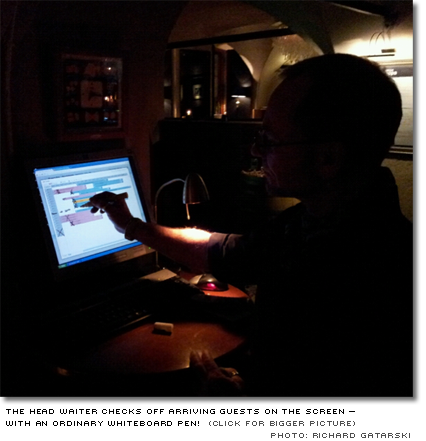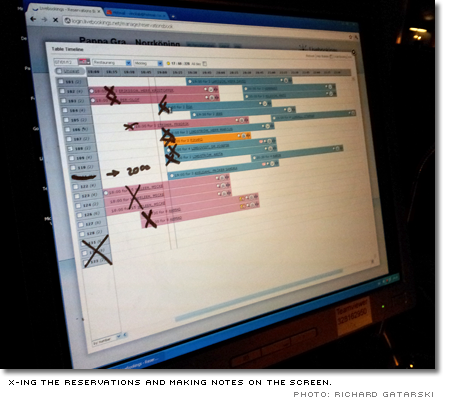When Richard Gatarski and a few friends wanted to dine in the Swedish city of Norrköping a few weeks ago, they booked a table at a downtown Italian restaurant that seemed nice.
When they arrived, they were greeted by the headwaiter, who asked if
they had a reservation. Richard confirmed, and the headwaiter looked at
his computer screen.
â€Gatarski? Hm, let’s see .. yes, there’s your reservation. Welcome!â€
The headwaiter then picked up what Richard first thought must be some
kind of new, electronic touch-pen, and moved it toward the screen.
Richard is a tech savvy Internet entrepreneur,
and therefore quite curious about what kind of new gadget they used at
this restaurant. So he leaned in and looked a little closer …

… and suddenly realized that it was a perfectly ordinary
whiteboard felt-tip pen. The headwaiter just draw an â€X†over their
booking, directly on the computer screen!
â€That’s very interesting,†Richard asked the headwaiter. â€How come you do that?â€
â€Well, you know,†the headwaiter answered with a big sigh. â€The guys that create these kinds of systems … they have …. Well, you can’t do things the way you wanna do them. You can check off a reservation in the system, with the mouse, but hey, it’s at least four clicks away from this screen. And you can’t tell if the guests have been showed to their table or are waiting in the bar. So it’s much easier just to draw on the screen. (And when the evening is over you just wipe the screen with a cloth.) We’re very busy here, and this works just fine.â€
The food, by the way, was excellent.
* * *
So, what does this real-world story tell us?
- Computer systems are not always used as the developers suppose.
- People are creative. If they can, they will invent ways to simplify their everyday tasks.
- â€We’re very busy.†Users have a lot of more important things to do at work. The time to learn things, for which the value or purpose is not obvious, is rather spent on things we think are more important (like, making the best sauce the customer has ever tasted).
- Doesn’t the expense for a booking system seem all wasted here? A small real-world whiteboard would probably have solved the task at hand cheaper and simpler.
- There’s a possibility that the computerized booking system (as opposed to a real whiteboard) could generate some kind of statistics: number of guest per month, typical reservation profile for a week, percentage of tables booked for any given period … And the companies selling computer systems (of all kinds, in many businesses) usually push the possibilities to get such data as big advantages with their system. But is it worth the effort? In many cases, a headwaiter would probably know most of what really matters anyway from experience or rule-of-thumb. So the hassle of going through a time-consuming number of clicks, just to generate that data, is probably not worth it.
- And finally: to really find out what’s important to the users, and how a system is actually used, you need to observe real users, in the field.
What’s this: I’m a Swedish UX designer and writer,
specializing in systems used in the workplace. This blog is about my
most recent book, covering how such badly designed systems are a major cause of stress (and eventually health problems). You can read a bit more about it in English here. I tweet as @jonas_blind_hen.

(BTW, the book is quite a success over here; topping the best-seller list in its category.)
Many thanks to Richard for sharing this! :)
Source:http://javlaskitsystem.se/2012/02/whats-the-waiter-doing-with-the-computer-screen/
